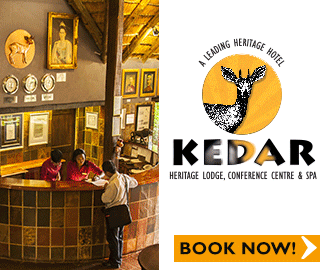
The Karo Tribe: Ethiopia’s Indigenous Group That Excels in Body Painting and Scarification
WORDS AND PHOTOGRAPHS BY MOZA MOYO 13 JULY, 2015 05:32
Somewhere in the Horn of Africa, there are ethnic tribes whose exotic traditions and way of life remain untouched by the modern world.
As expected, the Karo have specific rituals and ceremonies that define their culture. Like the Hamar and Bashada, they practice the Bula, or bull jumping, which signifies the coming of age for young men. An initiate has to prove his readiness for manhood by successfully jumping over rows of cattle six times in a row. Those who fail are disgraced while the successful boys qualify to marry and earn the right to appear in sacred places with elders of the clan.
Men scarify themselves too, but for a different reason: To symbolise courageous acts. If you see a Karo man with scars across his chest, you know that he has bravely killed enemies from rival tribes or a deadly animal. A man sporting scars on his chest is held in high esteem in his community. Each scar represents a single kill. Another merit bestowed on brave Karo warriors is the right to wear a grey and red ochre clay hair bun. Ostrich feathers are inserted in the hair bun to complete the stylish look. This coveted clay hair bun is often remade every three to six months, and can be worn for a period of up to one year.
Karo women usually don only a loincloth made from hide, and drape colourful beads around their necks. They lather their hair with ochre mixed with animal fat.
As expected, the Karo have specific rituals and ceremonies that define their culture. Like the Hamar and Bashada, they practice the Bula, or bull jumping, which signifies the coming of age for young men. An initiate has to prove his readiness for manhood by successfully jumping over rows of cattle six times in a row. Those who fail are disgraced while the successful boys qualify to marry and earn the right to appear in sacred places with elders of the clan. But there’s a catch: a young man can only marry if his older brothers have done so.

It is remarkable how, in the age of Internet revolutions and globalisation, the customs of the Omo tribes continue to survive and remain untainted. The only signs of a modern world in the Omo are plastic containers for fetching water from the river, T-shirts (which they hardly wear), and AK-47 riffles. The AK-47, which has flooded the region due to the on-going conflict in neighbouring Sudan and Somalia, has become the Omo tribes’ weapon of choice for protection against enemies and to protect their livestock from wild beasts.
The Omo Valley is truly unique. Its significance has been recognised by UNESCO, which named it a World Heritage Site in 1980. Simply put, no other place in the world boasts such a wide variety of people with such diverse cultures. Absolutely awe-inspiring stuff.

The Karo Tribe of Etiopia: A unique ethnic tribes whose exotic traditions and way of life remain untouched by the modern world Photo: Moza Moyo
Karo women usually don only a loincloth made from hide, and drape colourful beads around their necks. They lather their hair with ochre mixed with animal fat. Photo: Moza Moyo
The Karo are undeniably artistic by nature. Among other things, they are known for their alluring and intricate body and face painting. Photo: Moza Moyo

Women inflict lacerations and cuts on their chests, stomachs, or backs to produce intricate patterns of scars.
Photo: Moza Moyo
Men scarify themselves too, but for a different reason: To symbolise courageous acts. If you see a Karo man with scars across his chest, you know that he has bravely killed enemies from rival tribes or a deadly animal. Photo: Moza Moyo

It is remarkable how, in the age of Internet revolutions and globalisation, the customs of the Omo tribes continue to survive and remain untainted. The only signs of a modern world in the Omo are plastic containers for fetching water from the river, T-shirts (which they hardly wear), and AK-47 riffles.
The Lower Omo Valley in southern Ethiopia is home to over a dozen different tribes, who have lived there for centuries. Forming part of the estimated 200 000 indigenous peoples inhabiting the area are the Karo, who have a population of about 1000 to 2000, making them the smallest ethnic tribe in Ethiopia, probably in the continent as a whole. A deadly scourge of sleeping sickness is reported to have reduced their population at the end of the nineteenth century.
The Karo dwell along the banks of the Omo River (according to oral tradition, they settled at the Omo after following a red bull there almost two centuries ago) and largely rely on the river’s annual flood for sustenance – much like the ancient Egyptians who lived along the Nile thousands of years ago. The Karo predominantly practice flood retreat cultivation, growing sorghum, maize, and beans. They also fish and breed cattle and goats.
Surrounded by more powerful and wealthier tribes, they created a complex social hierarchy to thwart intermarriage and keep their lineages pure. Their neighbours include the Hamar, Bana, Bashada, Nyangatom, and Mursi. The groups have always traded amongst each other for cloth, beads, cattle, and food. The Karo are closely related to the Harmar tribe, who speak virtually identical Omotic languages. These two tribes are of the same ancestry and some of their cultural practices allude to a rich cultural history together.
The Karo are undeniably artistic by nature. Among other things, they are known for their alluring and intricate body and face painting. They decorate their bodies with locally found white chalk, yellow mineral rock, iron ore and charcoal. This is an elaborate process with designs ranging from simple and fine dots to rough but remarkable lines traced with palms or fingers. Animal motifs such as the spotted plumage of the guinea fowl are some of the striking body painting designs they do. Both men and women practice this symbolic and ornamental expression in a bid to appear more attractive to the opposite sex. It’s also done on special occasions.
Beauty is an important aspect of the Karo’s cultural tradition, and for the women, it is literally ingrained deep in their bodies. Women inflict lacerations and cuts on their chests, stomachs, or backs to produce intricate patterns of scars. Again, all this is done for beauty reasons, as a woman with these types of scars on her torso is considered mature and attractive. The scars are cut with a knife or razor and ash is rubbed in to produce a permanent welt.
















